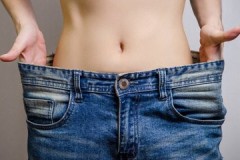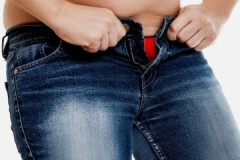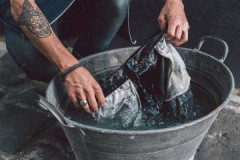Original and effective ways to quickly and correctly dry jeans after washing
 Denim is quite dense, so it dries for a long time after washing. Sometimes situations arise in which there is no way to wait 1-2 days.
Denim is quite dense, so it dries for a long time after washing. Sometimes situations arise in which there is no way to wait 1-2 days.
Then quick drying methods come to the rescue. In order not to damage the thing, you need to follow certain rules.
How to quickly and properly dry jeans at home after washing, the article will tell you.
Content
General rules
To avoid ruining your jeans during emergency drying, the following points must be taken into account:
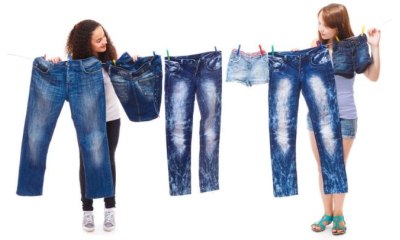 The more often the pants are subjected to such processing, the faster they will lose their attractive appearance. It is necessary to resort to extreme methods only in case of urgent need.
The more often the pants are subjected to such processing, the faster they will lose their attractive appearance. It is necessary to resort to extreme methods only in case of urgent need.- If you squeeze out the product badly, then it will dry for a long time, regardless of the conditions created.
- Under no circumstances should jeans be dried near sources of open fire, and even more so, leave them unattended. The same rule applies to electrical appliances.
- Keep your pants straight while drying. Otherwise, creases will form on them. You can get rid of them only with repeated washing jeans.
Direct sunlight promotes rapid evaporation of moisture. However, under their influence, dark fabrics fade, and white jeans can turn yellow.
Natural drying at home
The optimal drying method is natural conditions, namely:
- Dry room with low humidity. Most often, this place is the living room. They dry things in it in the cold season.
- Well ventilated shaded area. It can be a loggia or a balcony. People living in a private home can choose a backyard or other suitable location.
- No heat sources in the immediate vicinity in the form of heating devices or fire sources.
Throwing jeans over a crossbar or rope is not recommended, so as not to form creases.
Natural drying does not involve the risk of product deterioration, but it has one significant drawback - it is a long time period. The whole process can take 1-3 days. The exact time depends on the environment.
How to speed up the process?
Fast drying can take anywhere from a few minutes to several hours. It all depends on how wet the fabric is. You can cope with the task using various devices.
A battery, iron, fan and even a microwave come to the rescue.... Each method has its own pros and cons that must be considered.
Iron
The iron is the most affordable and safest device with which you can dry wet jeans.
Instructions for its use:
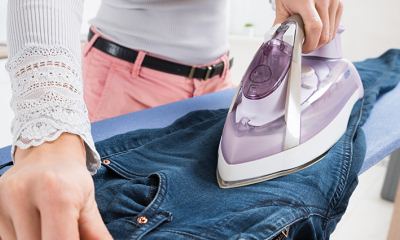 turn the thing to the wrong side;
turn the thing to the wrong side;- lay your pants on an ironing board or other flat surface;
- set the maximum temperature on the iron;
- if the fabric sticks to the sole of the iron, then the degrees must be reduced;
- iron the fabric systematically, paying special attention to the belt, seams and pockets;
- continue ironing until the item is dry.
This method is good because it does not damage the product. Its disadvantage is that the entire process takes about an hour. During this time, you can get tired and burn a lot of electricity.
You can put a terry towel underneath to help the moisture evaporate from your jeans.
Fan or hairdryer
A hairdryer or fan heater will help to cope with the task in 20-30 minutes. These devices are used as follows:
- Turn the pants over to the wrong side.
- Lay them out on a flat surface, giving the correct shape.
- Set the device to full power and the highest temperature.
- Direct the air flow into the product. Then the pants are dried outside.
- Do not bring the device too close to the thing. This can cause the fibers to catch fire, create holes and create an unpleasant odor.
Electric dryer
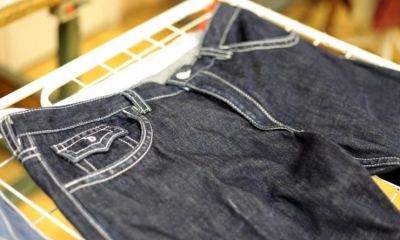 Drying jeans with an electric dryer is easy. It is enough to lay out the product on strings and plug the device into the mains.
Drying jeans with an electric dryer is easy. It is enough to lay out the product on strings and plug the device into the mains.
Turn your pants over every 40 minutes so that they dry evenly... The average drying time is 3-4 hours, as the appliance does not get very hot.
This is an effective and safe way, but its main disadvantage is that not every home has an electric dryer. The average cost of the device is about 5,000 rubles.
Drying your jeans this way will not leave rust stains, but white streaks may appear. It will be possible to get rid of them only by repeated washing.
Battery
A heating radiator can come to the rescue during the cold season... You can dry your jeans on it as follows:
- lay out the pants on the battery so that they are as even as possible;
- after 60 minutes, turn the product over to the other side;
- after another hour, check the condition of the thing - if the drying is complete, the jeans are removed.
The disadvantages of this method include the fact that cast iron appliances can leave yellow stains on the fabric. This is especially true for white jeans. You can avoid stains by covering the radiator with a clean, dry cloth. However, this will increase the drying time.
Spin in the washing machine
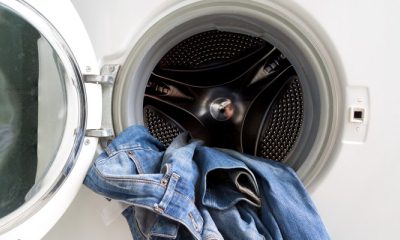 You can get rid of excess moisture using a washing machine.
You can get rid of excess moisture using a washing machine.
Instructions for use:
- Turn the product to the wrong side, fasten the zippers and buttons.
- Place the garment in the drum of the washing machine.
- Switch on spin mode. The speed should not exceed 800 revolutions.
After completing the cycle, the jeans need to be ironed, as they will not completely dry out, but they will be very wrinkled. If you have time, you can finish drying the product in natural conditions.
Oven
The oven allows you to cope with the task very quickly. You need to act as follows:
- preheat the oven to 120 degrees;
- open the door and hang wet jeans on it;
- being nearby, you need to turn them over every 5 minutes so that the fabric does not burn and dries evenly.
Place your jeans only on a clean surface so they don't have to be washed again.
The main advantage of this method is the high drying speed.... The fabric will dry out in 30-60 minutes. However, the method is fire hazardous.
The product may start to smolder and even ignite. Therefore, it is strictly prohibited to leave it unattended. For your own safety, you need to keep a container of water or a home fire extinguisher at hand.
You don't need to lay the fabric tightly. This will only delay the drying process.
With dry towels
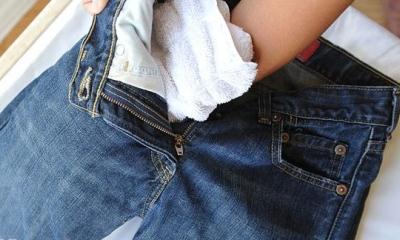 You can remove excess moisture with terry towels. They are used as follows:
You can remove excess moisture with terry towels. They are used as follows:
- Wrap jeans in a towel.
- One piece is placed inside each leg.
- Twist a strong tight tourniquet. It is most convenient to work together.
- They unfold their pants, change the towel.
- The procedure is repeated several times. Most often, 4-5 approaches are required.
The advantage of this method is that it does not harm the fabric and will not damage the product. However, you cannot dry your jeans completely with towels. They will still stay wet. Ironing is required to dry them completely.
To twist light-colored jeans, use towels that will not fade or leave marks on them.
Microwave
Make sure your jeans are free of metallic elements before placing them in the microwave. Otherwise, the device will simply fail.
If there is no metal on the clothes, then proceed as follows:
- put jeans in the microwave;
- include the "Warming up" mode;
- dry for 30 seconds, turn the product over and repeat the cycle.
Important recommendations
There are some tips to considerBefore you start drying your jeans:
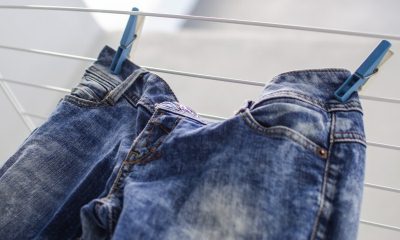 Make sure the item is clean. This must be done so that it does not have to be washed again.
Make sure the item is clean. This must be done so that it does not have to be washed again.- The better the pants are wrung out, the faster they dry.
- Wet laundry is excellent at absorbing odors. This must be taken into account when choosing the method and place for drying the product.
- If pants are to be ironed, do not dry them completely. Damp cloth is easier to iron.
- High temperatures can cause jeans to shrink. Therefore, you need to handle them carefully.
- Before you subject the pants to processing, they must be turned out to the wrong side. This will help protect the fabric from puffs, warping and stains.
- Dry jeans using steel or plastic fixtures, or on ropes. They will not cause rust stains on the fabric.
Useful video
How to speed up the drying of jeans, the video will tell you:
Conclusion
You can quickly dry your jeans with the help of available tools. The safest helpers are: iron, washing machine, towel and electric dryer... Extreme methods (oven and microwave drying) should only be used in an emergency.

